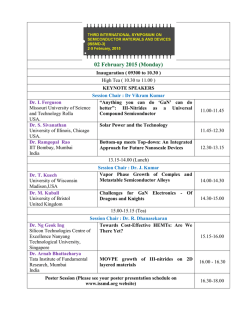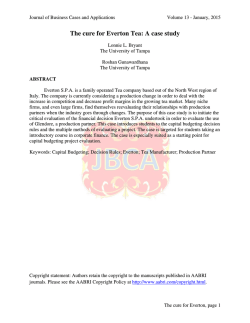
Medicinal Benefits of Green Tea: Part I. Review of
THE JOURNAL OF ALTERNATIVE AND COMPLEMENTARY MEDICINE Volume 11, Number 3, 2005, pp. 521–528 © Mary Ann Liebert, Inc. Medicinal Benefits of Green Tea: Part I. Review of Noncancer Health Benefits RAYMOND COOPER, Ph.D.,1 D. JAMES MORRÉ, Ph.D.,2 and DOROTHY M. MORRÉ, Ph.D.3 ABSTRACT Tea, in the form of green or black tea, is one of the most widely consumed beverages in the world. Extracts of tea leaves also are sold as dietary supplements. However, with the increasing interest in the health properties of tea and a significant rise in scientific investigation, this review covers recent findings on the medicinal properties and noncancer health benefits of both green and black tea. In Part II, a review of anticancer properties of green tea extracts is presented. Green tea contains a unique set of catechins that possess biological activity in antioxidant, anti-angiogenesis, and antiproliferative assays potentially relevant to the prevention and treatment of various forms of cancer. Although there has been much focus on the biological properties of the major tea catechin epigallocatechin gallate (EGCg) and its antitumor properties, tea offers other health benefits; some due to the presence of other important constituents. Characteristics unrelated to the antioxidant properties of green and black teas may be responsible for tea’s anticancer activity and improvement in cardiac health and atherosclerosis. Theanine in green tea may play a role in reducing stress. Oxidized catechins (theaflavins in black tea) may reduce cholesterol levels in blood. Synergistic properties of green tea extracts with other sources of polyphenolic constituents are increasingly recognized as being potentially important to the medicinal benefits of black and green teas. Furthermore, due to presumed antioxidant and antiaging properties, tea is now finding its way into topical preparations. Each of these aspects is surveyed. INTRODUCTION T ea is generally consumed in the form of black, oolong, or green tea; which are all preparations originating from Camellia sinensis, a small plant grown mainly in China and southeast Asia. Tea is cultivated in approximately 30 countries worldwide and is consumed globally. Although the level of tea consumption varies around the world, it is believed to be second only to water.1 Black tea is consumed predominantly in Western and some Asian countries and green tea is consumed predominantly in China, Japan, India, and a number of countries in north Africa and the Middle East.1 Tea originated in southwest China 5000 years ago and was originally used as a medicine for various illnesses as a bitter concoction suggesting that the young leaves rich in catechins were used.2 It is thought that at first tea leaves were used by rolling them with a milk product into cheeselike balls that would temper their somewhat bitter taste. As the boiling of water became widespread, drinking tea became normal practice. Tea was drunk from wooden bowls and the water boiled in terracotta vessels. The tea was stored in the form of powder, leaves, and cakes. Small pieces would be broken off the cakes and steeped in water. Traditional Chinese Medicine (TCM) stresses prevention and drinking tea was recommended to healthy people between 1100 BC and 200 BC.3 It was not until the T’ang dynasty (618–907 AD) that tea, long appreciated for its medicinal properties, became an object of veneration and the tea trade inside China flourished. Subsequently, drink- 1PhytoScience, Inc., Los Altos, CA. of Medicinal Chemistry and Molecular Pharmacology, Purdue University, West Lafayette, IN. 3Department of Foods and Nutrition, Purdue University, West Lafayette, IN. 2Department 521 522 COOPER ET AL. ing tea has been regarded in Asia as a generally healthful practice. Because successful tea cultivation requires moist humid climates, the slopes of northern India, Sri Lanka, Tibet, and southern China provide some of the ideal growing areas.4 Green tea is sold as fresh or dried unfermented leaves. A highly prized collection comes from picking the very early shoots, which are almost white in color and much sought after. Tea flush is the term for these young shoots, consisting of a terminal bud and two adjacent leaves. Total polyphenols in these early shoots comprise 20% to 35% by weight, 60–80% of which are catechins. Green tea processing leads to a concentration of 15%, but the major differences in cultivation practices for Camellia sinensis—harvest season, age of the leaf (plucking position), climate, environmental stress, horticulture practices, processing, and storage—are directed at producing drinking teas.5,6 The preparation of black tea requires “fermentation.” As the fresh leaves are allowed to wither and are crushed, a natural oxidative process takes place, resulting in the formation of higher molecular weight condensed polyphenolic constituents, giving black tea a stronger, more tannic flavor (Fig. 1). A less extensive, incomplete fermentation generally leads to a lighter flavored tea, popular in certain parts of Asia, known as oolong tea. Table 1 shows typical levels of the major phenolic constituents found in green and black teas. During fermentation, catechins in green tea are partially converted to theaflavins. There are many excellent references covering the chemical constituents of tea and its pharmacological properties.7,8 Scientists have identified many of the natural substances in green tea that may provide the majority of its health benefits. The major polyphenol belonging to the family of catechins and found in green tea is (-)-epigallocatechin gallate (EGCg), with lesser amounts of catechin (C), epicatechin (EC), gallocatechin (GC), gallocatechin gallate (GCG), epigallocatechin (EGC), and epicatechin gallate (ECG) (Fig. 2). In addition, caffeine, theanine, theaflavins, theobromine, theophylline, and phenolic acids such as gallic acid are Theaflavins & Thearubigins Catechins White Tea (buds or young leaves) Steamed (oxidase inactivation) Dried Green Tea (mature leaves) Withered Dried Oolong Tea (mature leaves) Withered Black Tea (mature leaves) Withered FIG. 1. Steamed or Panfired (oxidase inactivation) Bruised Rolled Partially Panfired Fermented Fully Fermented Fired Dried Dried Schematic of the tea extraction processes. TABLE 1. TYPICAL LEVELS OF CONSTITUENTS FOUND IN BLACK AND GREEN TEA Compound Green tea (cup) Black tea (cup) Catechins Theaflavins Caffeine L-theanine 60–125 mg — 20–50 mg0 20–40 mg0 30–60 mg 3.0–6.0 mg 30–60 mg 20–40 mg present in smaller quantities.9 Chemical analyses and analytical methods, mostly using high performance liquid chrotometry (HPLC) and liquid chromatography-mass spectography (LC-MS) techniques, are now widely available for detection of these catechins.9 There has been considerable interest in the breakdown products in the human body, leading to chemical studies of the metabolites of polyphenolic content in green tea extracts based on extensive HPLC analyses. A complete separation of these major constituents has been achieved (Cooper and Zhang 2004, unpublished results (Fig. 3). Quality control is improving, and standardization of the ratio and variation of the catechins in commercially available green tea extracts is leading to the availability of consistently prepared material. Because these standardized preparations will in turn be used in clinical study, there will be more confidence in the results of any future clinical evaluations. Weight loss Recent studies have suggested a role for catechins in promoting weight loss.10 In an animal study,11 the antiobesity effect of green tea was evaluated by feeding different levels of green tea (from 1% to 4% of their diets) to female mice for 4 months. The results showed that the mice fed green tea in their diets had a significant suppression of food intake, body weight gain, and fat tissue accumulation. In addition, levels of cholesterol and triglycerides were lower. Perhaps the most interesting finding from this study was that serum leptin levels showed a decrease, indicating that green tea may have a direct beneficial effect leading to weight loss. In some studies, green tea is associated with a mild increase in thermogenesis (increased caloric expenditure), which is generally attributed to its caffeine content.12,13 At least one study has shown that green tea extract stimulates thermogenesis to an extent that is much greater than can be attributed to its caffeine content, meaning that the thermogenic properties of green tea may be due to an interaction between its high content of catechin polyphenols with caffeine. A probable theory for the thermogenic effect of green tea is an increase in levels of norepinephrine, because catechin polyphenols are known to inhibit catechol-O-methyltransferase, the enzyme that degrades norepinephrine. A randomized, placebo-controlled study of 10 individuals was conducted to investigate whether a green tea extract could 523 NONCANCER BENEFITS OF GREEN TEA OH OH OH OH O HO O HO OH OH OH OH OH (–)-Epicatechin (–)-Epigallocatechin OH OH OH OH O HO HO OH OH OH O C O OH O OH O C O OH OH OH OH (–)-Epigallocatechin gallate (–)-Epicatechin gallate OH OH HO OH O OH OH OH O HO O OH O OH O OH OH HO OH OH O OH Theaflavin O HO O OH O O OH O O HO OH O OH OH OH OR Theaflavin 3.3′-digallate OH n Thearubigins FIG. 2. Chemical structures of tea constituents. increase energy expenditure and fat oxidation in humans over 24 hours.12 Compared to placebo, the green tea extract resulted in a significant (4%) increase in energy expenditure (p 0.01) and a significant decrease in respiratory quotient with no change in urinary nitrogen. Twenty-four-hour urinary excretion of norepinephrine was higher during treatment with the green tea extract than with placebo. Treatment with caffeine in amounts equivalent to those found in the green tea extract (50 mg) had no effect on energy expenditure or fat oxidation, suggesting that the thermogenic properties of green tea are due to compounds other than its caffeine content alone. These studies on the thermogenic properties of green tea extract have demonstrated a synergistic interaction between caffeine and catechin polyphenols that appears to prolong sympathetic stimulation of thermogenesis.12,13 Treatment 524 COOPER ET AL. G G C EC C EG af fe in e DAD1 A, Sig=280, 16 Ref=650,25 (POLYPHEN/04050303,D) mAU 2500 10:1 ratio of 28% Theaflavins extract and Lipton Tea Bag leaves Theaflavin CG C EGC 1000 GC Theanine GCG 1500 500 Theaflavin-3-gallate Theaflavin-3′-gallate Theaflavin-digallate EC 2000 0 0 10 20 30 40 50 60 min FIG. 3. High performance liquid chromatography profile of major constituents found in green and black teas. with caffeine alone in amounts equivalent to those found in the green tea extract had no effect on energy expenditure and respiratory quotient or on urinary nitrogen or catecholamine excretion. The authors concluded that green tea has thermogenic properties and promotes fat oxidation beyond that explained by its caffeine content, with the green tea extract having a role in the control of body composition via sympathetic activation of thermogenesis, fat oxidation, or both. The green tea extract may stimulate brown adipose tissue thermogenesis to an extent which is much greater than can be attributed to its caffeine content, with thermogenic properties residing primarily in an interaction between its catechin polyphenol and caffeine content with sympathetically released noradrenaline.13 Cardiac health and theaflavins Green and black teas are sources of bioactive flavonoids with antioxidant activity.14 The fermentation process used to prepare black tea converts many of the simpler catechin flavonoids in green tea leaves to more complex phenolic constituents such as theaflavins.15 Experimentally, some catechins have been shown to inhibit a key enzyme (squalene epoxidase) in the pathway of cholesterol biosynthesis.16 Theaflavin was found to be twice as effective in blocking the activity of this enzyme.17 Unlike hydroxymethyl glutaryl-coenzyme A (HMG-CoA) reductase inhibitors, black tea flavonoids do not interrupt the synthesis of CoQ10. In animals, catechins reduce the solubility of cholesterol in micelles—an action consistent with the observation that high doses of tea modulate cholesterol levels in animals fed high cholesterol or sugar diets.18–20 Tea consumption has been associated with decreased car- diovascular risk. While epidemiologic studies suggest that drinking multiple cups of tea per day lowers low-density lipoprotein (LDL) cholesterol, previous trials of tea drinking and administration of green tea extract have failed to show any impact on lipids and lipoproteins in humans. Maron et al. studied the impact of a theaflavin-enriched green tea extract on the lipids and lipoproteins of subjects with mild to moderate hypercholesterolemia.21 A total of 240 men and women 18 years or older on a low-fat diet with mild to moderate hypercholesterolemia were randomly assigned to receive a daily capsule containing theaflavin-enriched green tea extract (375 mg) or placebo for 12 weeks. Each active capsule contained 75 mg of theaflavins, 150 mg of green tea catechins, and 150 mg of other tea polyphenols. The extract was produced from raw Camellia sinensis leaves through a controlled fermentation process in which catechins were dimerized to form theaflavins. The main outcome measures were mean % changes in total cholesterol, LDL-C, high-density lipoprotein cholesterol (HDL), and triglyceride levels compared with baseline. The theaflavin-enriched green tea extract was shown to be an effective adjunct to a low-saturated-fat diet to reduce LDL in hypercholesterolemic adults and was well tolerated.21 A study22 that followed 8522 Japanese men and women over a period of 12 years found that men who drank 10 cups (32 ounces) of green tea daily had a 58% reduced risk of death from coronary heart disease compared to those who drank 3 cups a day (10 ounces) or less. A Dutch study over 6 years of 4807 men and women showed that those who drank more than 3 cups (13 ounces/day) of black tea had a 68% reduced risk of myocardial infarction over nontea drinkers. In a study of 55223 elderly Dutch men over a period of 15 years, the risk of stroke for those who drank more than 4.7 cups/day (20 ounces/day) of black tea was only 31% that of men who drank less than 2.6 cups/day (11 ounces/day). Acute ingestion of both teas has been shown to inhibit LDL oxidation in human volunteers.24 Regular, frequent consumption of tea (3 or more cups daily) may reduce the risk of heart attack, according to a recent meta-analysis.25 Some studies, though not all, link lower risk of heart disease with drinking large amounts of tea compared to little or none.26,27 Hong et al28 examined the effects of green tea extract on cyclo-oxygenase (COX) and lipoxygenase (LOX)– dependent arachidonic acid metabolism. Normal human colon mucosa and colon tumor tissues were investigated. At doses of 30 g/mL, EGCg, EGC, and ECG from green tea and theaflavins from black tea inhibited LOX-dependent activity by 30% to 75%. Inhibitory effects on COX were less pronounced. Geleijnse et al.23 investigated the association of tea and flavonoid intake with incident myocardial infarction in a Dutch population. Data were taken from a longitudinal analysis performed by using data from the large Rotterdam 525 NONCANCER BENEFITS OF GREEN TEA study conducted from 1990 to 1993 restricted to men and women older than 55. They suggested an increased intake of tea may contribute to primary prevention of ischemic heart disease. Green tea and tea catechins have been shown to be hypolipidemic.18,29 Yang and Koo treated hypocholesterolemic rats with green tea and examined the effect on HMG CoA reductase and other lipid enzymes.30 They demonstrated a lowering of serum total cholesterol and elevated HDL levels. Furthermore, they demonstrated the inhibitory effect of green tea on endothelial cell-induced LDL oxidation, suggesting that green tea may delay atherogenesis and lower the risk of coronary heart disease.31 Miura et al.32,33 noted that aortic cholesterol and triglyceride levels were 27% and 50% lower, respectively, over control mice after administration of green tea extract to male apoE-deficient mice. Their results suggested that chronic ingestion of tea extract prevents development of atherosclerosis without changing the plasma lipid level in apoE-deficient mice and they speculated that the mechanism is due to the potent antioxidative activity of the tea, although more specific actions may be responsible. For heart disease protection, the potent antioxidant properties of polyphenols reduce free radical damage to cells and prevent the oxidation of LDL cholesterol, both of which would be expected to inhibit the formation of atherosclerotic plaques.29,34–38 Arthritis An antioxidant-rich polyphenolic fraction isolated from green tea has been reported to possess anti-inflammatory properties in laboratory animals.39 One laboratory study reported positive benefits on collagen-induced arthritis in mice. The mice exhibited a significant reduction in the incidence of arthritis (33%) compared with mice not given green tea polyphenols (50%). Analysis showed a marked reduction in the expression of inflammatory mediators such as cyclooxygenase 2, interferon (IFN)-, and tumor necrosis factor (TNF)- in the arthritic joints of the mice fed green tea polyphenols. Additionally, total IgG and type II collagen-specific IgG levels were lower in the serum and arthritic joints of the treated mice.39 Bone density A study of 1256 women in the United Kingdom aged 65 to 76 (1134 tea drinkers and 122 non-tea drinkers) reported that tea drinkers had significantly greater mean bone mineral density measurements (5%, adjusted for age and body mass index), independent of smoking status, the use of hormone replacement therapy, coffee drinking, and whether milk was added to tea.40 The authors concluded that drinking tea may help protect against osteoporosis in older women. However, an animal study has reported that tannins contained in black and green teas may decrease the absorption of calcium and iron to some extent.41 In the study, green tea decreased the absorption rate of zinc while black tea reportedly increased the rate. Both teas promoted the absorption of manganese and copper. Stress and theanine One of the reasons that green tea has been used in the Orient for centuries is its calming and curative properties due to the presence of L-theanine, an amino acid found primarily in green and black teas that produces tranquilizing effects in the brain.42,43 Through the natural production of polyphenols, the tea plant converts theanine into catechins. This means that tea leaves harvested during one part of the growing season may be high in catechins (good for antioxidant benefits), while leaves harvested during another time of year may be higher in theanine. Three to four cups of green tea are expected to contain from 60 to 160 mg of theanine. Recently, L-theanine has been linked to the feelings of relaxation reported by those who drink green tea. Experimental studies have also shown that L-theanine appears to negate some of the effects of caffeine.42 L-theanine facilitates the generation of alpha waves in the brain believed to be associated with a relaxed yet alert mental state. A clinical study on L-theanine using young women subjects showed that L-theanine seemed to have the greatest impact on the production of alpha waves among those women who had been categorized as high-anxiety subjects.42 Theanine is believed to lower cortisol levels during stress periods (cortisol production in the body increases during physical stress). Research studies have found that people who produce more alpha brain waves also have less anxiety and highly creative people generate more alpha waves when faced with a problem to solve. Elite athletes tend to produce a burst of alpha waves on the left side of their brains during their best performances. One of the specific aspects of theanine activity is its ability to increase the brain’s output of alpha waves. Alpha waves are one the four basic brainwave patterns (delta, theta, alpha, and beta) that can be monitored using an electroencephalogram (EEG). Each wave pattern is associated with a particular oscillating electrical voltage in the brain, and the different brainwave patterns are associated with different mental states and states of consciousness (theta drowsiness; alpha relaxed/alert; beta stress/anxiety). Studies in rats have shown theanine to be an effective antihypertensive agent.44 In these studies, it is interesting to note that theanine was able to bring elevated blood pressure back toward normal levels, but had no effect on normal blood pressure levels.45,46 Because theanine reaches its maximum levels in the blood between 30 minutes and 2 hours after ingestion, it can be 526 used as both a daily antistress and mental focus regimen and as needed as a supplement during stressful times. Studies on rodents have shown that the ability to learn and remember may be enhanced with theanine supplementation.47,48 This natural relaxant works to diminish stress, worry, and anxiety, and may allow the brain to focus and concentrate better.43 Antiviral properties Tea catechins exhibit a protective effect against human immunodeficiency virus (HIV) infection, partly mediated by inhibiting virions to bind to the target cell surface.49,50 Kawai et al. investigated the mechanism of the anti-HIV effect of green tea polyphenols and clearly demonstrated that EGCg (but not ECG) directly binds to the cell-surface CD4 molecules.51 It remains to be seen whether these effects are seen in humans and more studies are needed. COOPER ET AL. CONCLUSIONS In summary, a number of significant scientific studies have confirmed the health benefits of tea. In this review we coverered noncancer health benefits of both green and black tea. In Part II, a review of anticancer properties of green tea extracts will be presented.63 The green tea catechins possess various biological activities in antioxidant, anti-angiogenesis, and antiproliferative assays potentially relevant to the prevention and treatment of various forms of cancer. Although much focus has been put on the biological properties of the major tea catechin EGCg and its antitumor properties, other health benefits due to the presence of theanine and theaflavin constituents have been described. We believe that in future more studies will focus on these important constituents, further confirming a linkage between standardized extracts and a clinical target through a biological effect. Anticariogenic effects Human and laboratory studies have supported the use of green tea as a preventative measure in dental caries.52,53 Salivary amylase hydrolyzes food starch to low molecular weight carbohydrates (maltose) that are easily fermentable. A recent study reported that consumption of tea (black or green) inhibits the release of maltose up to 70%.54 Black tea was a more potent inhibitor than green tea. Another study reported that a green tea extract was effective in reducing the gingival inflammation caused by periodontal structures such as dentures.55 An in vitro study reported that a green tea extract strongly inhibited Escherichia coli, Streptococcus salivarius, and Streptococcus mutans.56 The antibacterial effects of green and black tea extracts were comparable with those of amoxicillin, cephradine, and eugenol. Ultraviolet skin protection There have been several animal studies that support the use of green tea in the prevention of ultraviolet (UV)-induced skin carcinogenesis and as topical skin protection against UV radiation.57–60 Similar results have been reported from in vitro studies on human skin.61 A recent human study reported that a topical application of EGCg prior to exposure to UV radiation had preventative effects on damage to the skin.62 A single UV exposure of 4 minimal erythema doses (MED) to human skin was found to increase catalase activity (109–145%) and decrease glutathione peroxidase (GPx) activity (36–54%) and total glutathione (GSH) level (13–36%) at different time points studied. Pretreatment of the skin with EGCg from green tea was found to restore the UV-induced decrease in GSH level and protection of the skin to GPx. Further studies are warranted to elucidate the preventive effects of EGCg against multiple exposures of human skin to UV light. REFERENCES 1. Ahmad N. Nutrition and Chemical Toxicity. Sussex, England: John Wiley and Sons, 1998:301–343. 2. Chen ZM, Yu YM. Tea. In: Arntzen CJ, Ritter EM, eds. Encyclopedia of Agricultural Science. San Diego: Academic Press, 1994:281–288. 3. Yao GK, Chen PF. Tea Drinking and Health. Shanghai: Shanghai Culture Publishers, 1995:6–7. 4. Stella A. The Book of Tea. Milan: Mondadori Publishing, 1992. 5. Lin, YS, Tsai YJ, Tsay JS, Lin JK. Factors affecting the levels of tea polyphenols and caffeine in tea leaves. J Agric Food Chem 2003;51:1864–1873. 6. Wang LF, Kim DM, Lee CY. Effects of heat processing and storage on flavanols and sensory qualities of green tea beverages. J Agric Food Chem 2000;48:4227–4232. 7. McKenna DJ, Jones K, Hughes K. Green Tea in botanical Medicines. In: The Desk Reference for Major Herbal Supplements, 2nd ed. New York: Haworth Press, 2002:597–656. 8. Yang CS, Maliaka P, Meng X. Inhibition of carcinogenesis by tea. Annual Rev Pharmacol Toxicol 2002;42:25–54. 9. Manning J, Roberts JC. Analysis of catechin content of commercial green tea products J Herb Pharmacother 2003;3; 19–32. 10. Kao YH, Hiipakka RA, Liao S. Modulation of endocrine systems and food intake by green tea epigallocatechin gallate. Endocrinology 2000;141:980–987. 11. Sayama K, Lin S, Zheng G, Oguni I. Effects of green tea on growth, food utilization, and lipid metabolism in mice. In Vivo 2000;14:481–484. 12. Dulloo AG, Duret C, Rohrer D, Girardier L, et al. Efficacy of a green tea extract rich in catechin polyphenols and caffeine in increasing 24h energy expenditure and fat oxidation in humans. Am J Clin Nutr 1999;70:1040–1045. 13. Dulloo AG, Seydoux J, Girardier L, Chantre P, Vandermander J. Green tea and thermogenesis: Interactions between cat- NONCANCER BENEFITS OF GREEN TEA 14. 15. 16. 17. 18. 19. 20. 21. 22. 23. 24. 25. 26. 27. 28. 29. 30. echin-polyphenols, caffeine, and sympathetic activity. Int J Obes Relat Metab Disord 2000;24:252–258. Leung LK, Su Y, Chen R, Zhang Z, et al. Theaflavins in black tea and catechins in green tea are equally effective antioxidants. J Nutr 2001;131:2248–2251. Wang H, Helliwell K. Determination of flavonols in green and black tea leaves and green tea infusions by HPLC. Food Res Inter 2001;34:223–227. Abe I, Kashiwagi Y, Noguchi H, Tanaka T, et al. Ellagitannins and hexahydroxydiphenoyl esters as inhibitor of vertebrate squalene epoxidase. J Nat Prod 2001;64:1010–1014. Abe I, Seki T, Umehara K, Miyase T, et al. Green tea polyphenols: Novel and potent inhibitors of squalene epoxidase. Biochem Biophys Res Comm 2000;268:767–771. Ikeda I, Imasato Y, Sasaki E, Nakayama M, et al. Tea catechins decrease micellar solubility and intestinal absorption of cholesterol in rats. Biochim Biophys Acta 1992;1127:141– 146. Chan PT, Fong WP, Cheung YL, Huang Y, et al. Jasmine green tea epicatechins are hypolipidemic in hamsters (Mesocricetus auratus) fed a high fat diet. J Nutrition 1999;129:1094–1101. Yang M-H, Wang C-H, Chen H-L. Green, oolong, and black tea extracts modulate lipid metabolism in hyperlipidemic rats fed high-sucrose diets. J Nutr Biochem 2001;12:14–20. Maron DJ, Lu GP, Cai NS, Zong Gui Wu ZG, et al. Cholesterol-lowering effect of a theaflavin-enriched green tea extract. A randomized controlled trial. Arch Intern Med 2003;163: 1448–1453. Imai K, Suga K, Nakachi K. Cancer-preventive effects of drinking green tea among a Japanese population. Prev Med 1997;6:769–775. Geleijnse JM, Launer JL, van der Kuip DAM, Hofman A, Witteman JCM. Inverse association of tea and flavonoid intakes with incidental myocardial infarction: The Rotterdam study. Am J Clin Nutr 2002;75:880–886. Hodgson JM, Puddey IB, Croft KD, Burke V, Mori TA, Caccetta RA-A, Beilin LJ. Acute effects of ingestion of black and green tea on lipoprotein oxidation. Am J Clin Nutr 2000;71: 1103–1107. Peters U, Charles Poole C, Arab L. Does tea affect cardiovascular disease? A meta-analysis. Am J Epidem 2001;154: 495–503. Hirano R, Momiyama Y, Takahashi R, Taniguchi H, Kondo K, Nakamura H, Ohsuzu F. Comparison of green tea intake in Japanese patients with and without angiographic coronary artery disease. Am J Cardiol 2002;90:1150–1153. Hakim IA, Alseif MA, Alduwaihy M, Al-Rubeaan K, AlNueim AR, Al-Attes OS. Tea consumption and the prevalence of coronary heart disease in Saudi adults: Results from a Saudi National Survey. Preventive Med 2003;36:64–70. Hong J, Smith TJ, Ho CT, August DA, Yang CS. Effects of purified green and black tea polyphenols on cyclooxygenaseand lipooxygenase-dependent metabolism of arachidonic acid in human colon mucosa and colon tumor tissues. Biochem Pharmacol 2001;62:1175–1183. Yang TTC, Koo MWL. Hypocholesterolemic effects of Chinese tea. Pharmacol Res 1997;35:505–512. Yang TTC, Koo MWL. Chinese green tea lowers cholesterol level through an increase in fecal lipid excretion. Life Sci 2000;66:411–423. 527 31. Yang TTC, Koo MWL. Inhibitory effect of Chinese green tea on endothelial cell-induced LDL oxidation. Atherosclerosis 2000;148:67–73. 32. Miura Y, Chiba T, Miura S, Tomita I, Umegaki K, Ikeda M, Tomita T. Green tea polyphenols prevent oxidative modification of low density lipoproteins: an ex-vivo study in humans. J Nutr Biochem 2000;11:216–222. 33. Miura Y, Chiba T, Tomita I, Koizumi H, Miura S, Umegaki K, Hara Y, Ikeda M, Tomita T. Tea catechins prevent the development of atherosclerosis in apoprotein-E deficient mice. J Nutr 2001;131:27–32. 34. Anderson JW, Diwadkar VA, Bridges SR. Selective effects of different antioxidants on oxidation of lipoproteins from rats. Proc Soc Exp Biol Med 1998;218:376–381. 35. Muramatsu K, Fukuyo M, Hara Y. Effect of green tea catechins on plasma cholesterol level in cholesterol-fed rats. J Nutr Sci Vitaminol (Tokyo) 1986;32:613–622. 36. Riemersma RA, Rice-Evans CA, Tyrell RM, Clifford MN, Lean ME. Tea flavonoids and cardiovascular health QJM 2001;94:277–282. 37. Sagesake-Mitane Y, Miwa M, Okada S. Platelet aggregation inhibitors in hot water extract of green tea. Chem Pharm Bull (Tokyo) 1990;38:790–793. 38. Sasazuki S, Kodama H, Yoshimasu K, Liu Y, et al. Relation between green tea consumption and the severity of coronary atherosclerosis among Japanese men and women. Ann Epidemiol 2000;10:401–408. 39. Haggi TM, Anthony DD, Gupta S. Prevention of collagen-induced arthritis in mice by a polyphenolic fraction from green tea. Proc Natl Acad Sci U S A 1999;96:4524–4529. 40. Hegarty VM, May HM, Khaw KT. Tea drinking and bone mineral density in older women. Am J Clin Nutr 2000;71: 1003–1007. 41. Zeyuan D, Bingying T, Xiaolin L. Effect of green tea and black tea on the metabolism of mineral elements in old rats. Biol Trace Elem Res 1998;65:75–86. 42. Talbott SM. The Cortisol Connection. New York: Hunter House, 2002. 43. Huber LG. Green tea catechins and L-theanine in integrative cancer care: A review of the research. Altern Complement Therap 2003;9:294–298. 44. Zhang G, Miura Y, Yagasaki K. Effects of dietary powdered green tea and theanine on tumor growth and endogenous hyperlipidemia in hepatoma-bearing rats. Biosci Biotechnol Biochem 2002;66:711–716. 45. Yokogoshi H, Kobayashi M. Hypotensive effect of gammaglutamylmethylamide in spontaneously hypertensive rats. Life Sci 1998;62:1065–1068. 46. Yokogoshi H, Kato Y, Sagesaka YM, Takihara-Matsuura T, et al. Reduction effect of theanine on blood pressure and brain 5-hydroxyindoles in spontaneously hypertensive rats. Biosci Biotechnol Biochem 1995;59:615–618. 47. Kakuda T, Yanase H, Utsunomiya K, Nozawa A, et al. Protective effect of gamma-glutamylethylamide (theanine) on ischemic delayed neuronal death in gerbils. Neurosci Lett 2000; 289:189–192. 48. Yokogoshi H, Terashima T. Effect of theanine R-glutamylethylamide on brain monoamines, striatal dopamine release, and some kinds of behavior in rats. Nutrition 2000;16: 776–777. 528 49. Fassina G, Buffa A, Benelli R, Varnier OE, et al. Polyphenolic antioxidant (-)-epigallocatechin-3-gallate from green tea as a candidate anti-HIV agent. AIDS 2002;16:939–941. 50. Yamaguchi K, Honda M, Ikigai H, Hara Y, Shimamura T. Inhibitory effects of (-)-epigallocatechin gallate on the life cycle of human immunodeficiency virus type 1 (HIV-1). Antiviral Res 2002;53:19–34. 51. Kawai K, Tsuno NH, Kitayama J, Okaji Y, et al. Epigallocatechin gallate, the main component of tea polyphenol, binds to CD4 and interferes with gp120 binding. J Allergy Clin Immunol 2003;112:951–957. 52. Otake S, Makimura M, Kuroki T. Anticaries effects of polyphenolic compounds from Japanese green tea. Caries Res 1991;25:438–443. 53. Horiba N, Maekawa Y, Ito M, Matsumoto T, Nakamura H. A pilot study of Japanese green tea as a medicament with antibacterial and bactericidal effects. J Endod 1991;17:122–124. 54. Zhang J, Kashket S. Inhibition of salivary amylase by black and green teas and their effects on the intraoral hydrolysis of starch. Caries Res 1998;32:233–238. 55. Krahwinkel T, Willershausen B. The effect of sugar-free green tea chew candies on the degree of inflammation of the gingiva. Eur J Med Res 2000;5:463–467. 56. Rasheed A, Haider M. Antibacterial activity of Camellia sinensis extracts against dental caries. Arch Pharm Res 1998;21: 348–352. 57. Elmets CA, Singh D, Tubesing K. Cutaneous photoprotection from ultraviolet injury by green tea polyphenols. J Am Acad Dermatol 2001;44:425–432. COOPER ET AL. 58. Ichihashi M, Ahmed NU, Budiyanto A. Preventive effect of antioxidant on ultraviolet-induced skin cancer in mice. J Dermatol Sci 2000;23:S45–S50. 59. Katiyar SK, Challa A, McCormick TS. Prevention of UVBinduced immunosuppression in mice by the green tea polyphenol (-)-epigallocatechin-3-gallate may be associated with alterations in IL-10 and IL-12 production. Carcinogenesis 1999;20:2117–2124. 60. Ley RD, Reeve VE. Chemoprevention of ultraviolet radiationinduced skin cancer. Environ Health Perspect 1997;105:981–984. 61. Zhao JF, Zhang YJ, Jin XH. Green tea protects against Psoralen plus Ultraviolet A-induced photochemical damage to skin. J Invest Dermatol 1999;113:1070–1075. 62. Katiyar SK, Afaq F, Perez A. Green tea polyphenol (-)-epigallocatechin-3–gallate treatment of human skin inhibits ultraviolet radiation-induced oxidative stress. Carcinogenesis 2001;22:287–294. 63. Cooper R, Morré DJ, Morré DM. Medicinal benefits of green tea: Part II. Review of anticancer properties. J Altern Complement Med 2005:in press. Address reprint requests to: Raymond Cooper, Ph.D. PhytoScience, Inc. P.O. Box 1935 Los Altos, CA 94023 E-mail: [email protected]
© Copyright 2025





